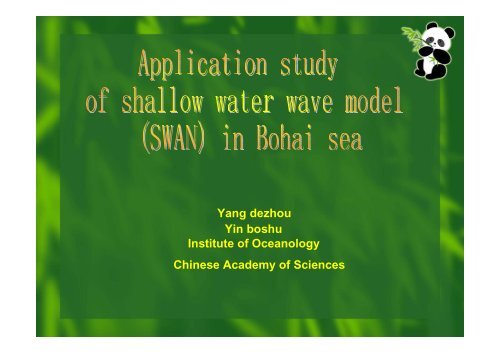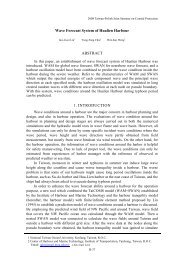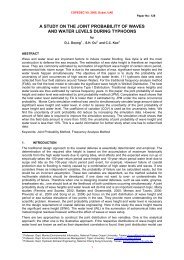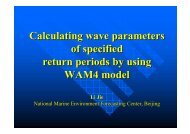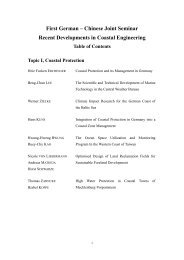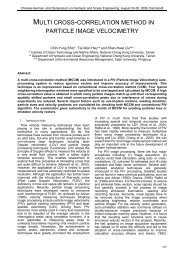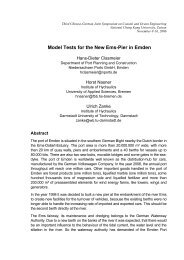03 Application study of shallow water wave model (SWAN)
03 Application study of shallow water wave model (SWAN)
03 Application study of shallow water wave model (SWAN)
Create successful ePaper yourself
Turn your PDF publications into a flip-book with our unique Google optimized e-Paper software.
Yang dezhou<br />
Yin boshu<br />
Institute <strong>of</strong> Oceanology<br />
Chinese Academy <strong>of</strong> Sciences
1: Abstract<br />
<br />
<br />
<br />
<br />
<strong>SWAN</strong> (Simulating Wave Nearshore) <strong>wave</strong> <strong>model</strong> has been put into use to<br />
examine its applicability in Bohai Sea.<br />
There is generally poor agreement between <strong>model</strong> results and<br />
measurements, when we use default parameters <strong>of</strong> the formulas used by<br />
<strong>SWAN</strong> to implement the simulations in Bohai Sea.<br />
Also, it is surprising that for the same wind process simulated results from<br />
two wind generation and three white-capping dissipation expressions (Komen<br />
and Janssen, Alkyon) demonstrated large difference.<br />
Further <strong>study</strong> showed that the proportionality coefficient in linear growth<br />
term <strong>of</strong> wind growth source function plays an unperceived role in the process<br />
<strong>of</strong> <strong>wave</strong> development.
Based on experiments and analysis, we found default constant<br />
coefficient should change rather than a constant. Therefore, a new<br />
changing coefficient with the variation <strong>of</strong> friction velocity u* was<br />
introduced into the linear growth term <strong>of</strong> wind growth source function in<br />
<strong>SWAN</strong> <strong>model</strong>.<br />
Then, we experimented with three weather processes (two cold <strong>wave</strong>s<br />
and a south wind) to validate the improvements in the linear growth term.<br />
It is found that the results from the improved <strong>SWAN</strong> <strong>wave</strong> <strong>model</strong> agree<br />
much better with the measurements than those from the previous <strong>SWAN</strong><br />
<strong>model</strong>.<br />
Furthermore, the large differences <strong>of</strong> results from two wind generation<br />
and three whitecapping dissipation expressions were eliminated.<br />
The improved <strong>SWAN</strong> <strong>wave</strong> <strong>model</strong> makes a solid foundation for<br />
setting up a proper <strong>model</strong> <strong>of</strong> <strong>wave</strong> numerical forecasting in Bohai Sea.
2:Background<br />
<br />
<br />
<br />
(1)The experiments <strong>of</strong> Becagra Toulany et al.<br />
Becagra Toulany et al indicated that for 20m/s winds and constant<br />
depths, Komen expression always gives higher Hs (significant<br />
<strong>wave</strong> heights) than Jassen expression.<br />
For long duration (>24hr) and large fetch, <strong>wave</strong> heights from<br />
Janssen is as much as 50% <strong>of</strong> Komen for depths in excess <strong>of</strong> 50m.<br />
By comparison, for 30m/s winds, Komen gives Hs estimates that<br />
are 30% in excess <strong>of</strong> Hs estimates resulted from Janssen<br />
expression. Study <strong>of</strong> simulation <strong>of</strong> a meteorological “bomb” for the<br />
NW Atlantic [1] suggested that the difference between Hs from<br />
Komen and Janssen expression is as much as 2m.
(2)Our experiments in different sea areas.<br />
When we use the <strong>SWAN</strong> <strong>model</strong> in Fushanwan<br />
bay ,we get results that always are not higher enough<br />
to match with the measurements.
3: Physical processes <strong>of</strong> <strong>SWAN</strong><br />
<br />
We only take the expressions <strong>of</strong> wind and whitecapping into<br />
consideration in our experiments.<br />
(1) Input by wind<br />
<br />
Wind energy to <strong>wave</strong>s is commonly described as the sum <strong>of</strong> linear<br />
and exponential growth. There are two kinds <strong>of</strong> wind growth<br />
<strong>model</strong>s in <strong>SWAN</strong> that are available for us. Both expressions <strong>of</strong><br />
wind growth <strong>model</strong> <strong>of</strong> them share the following form (1) and the<br />
same linear growth (2), while the exponential growth term is<br />
different.<br />
S in<br />
( σ , θ ) = A + B × E(<br />
σ , θ )<br />
A describes linear growth and B×E describes exponential growth.<br />
(1)
Linear growth by wind<br />
A<br />
=<br />
α<br />
[ U<br />
2 *<br />
max(0,cos( θ −θ<br />
w))]<br />
g 2π<br />
4<br />
H<br />
H<br />
= exp( −(<br />
σ / σ<br />
PM<br />
)<br />
* −4<br />
)<br />
*<br />
σ = 0.13g<br />
PM<br />
2π<br />
28U<br />
*<br />
We find the value is unsuitable to the <strong>shallow</strong> <strong>water</strong> applications.
Exponential growth<br />
a. Expression due to Komen et al. (1984) [2]:<br />
ρa<br />
U*<br />
B = max[ 0,0.25 (28 cos( θ −θw)<br />
−1)]<br />
× σ<br />
ρ C<br />
U*<br />
ρa<br />
w<br />
is friction velocity,<br />
ρw<br />
ph<br />
θ wind direction , C<br />
w<br />
ph<br />
and are the density <strong>of</strong> air and <strong>water</strong> respectively.<br />
b. Expression due to Janssen (1991) [4]:<br />
is the phase speed,<br />
B<br />
ρa<br />
U*<br />
2<br />
2<br />
= β ( ) (max( 0,cos( θ −θw)))<br />
× σ<br />
ρ C<br />
w<br />
ph<br />
β is the Miles “constant”.
(2) Two expressions <strong>of</strong> white-capping<br />
a: White-capping is primarily controlled by the steepness <strong>of</strong> the<br />
<strong>wave</strong>s. In presently operating third generation <strong>wave</strong> <strong>model</strong>s<br />
(including <strong>SWAN</strong>) the white-capping formulations are based on a<br />
pulse-based <strong>model</strong> (Hasselmann, 1974) [5], as adapted by the<br />
WAMDI group (1988) :<br />
S<br />
ds<br />
Γ = Γ<br />
~ k<br />
, w<br />
( σ , θ ) = −Γσ<br />
~ E(<br />
σ , θ )<br />
k<br />
KJ<br />
k ~ s<br />
= C<br />
ds<br />
(( 1−δ ) + δ ~)( )<br />
k<br />
~ s<br />
Γ is a steepness dependent coefficient, k is <strong>wave</strong> number ,<br />
σ ~ denote a mean frequency and k ~ a mean <strong>wave</strong> number, respectively.<br />
PM<br />
p
Komen et al. (1984) estimated the value <strong>of</strong> Γ by closing the energy<br />
balance <strong>of</strong> the <strong>wave</strong>s in fully developed conditions. This implies that this<br />
value depends on the wind input formulation that is used.. Since two<br />
different wind input formulations are used in <strong>SWAN</strong> <strong>model</strong>, two sets <strong>of</strong><br />
coefficients are used. For the wind input <strong>of</strong> Komen et al: C =2.36×10 -5<br />
ds<br />
, p=4, and δ = 0 which are the default value in <strong>SWAN</strong> <strong>model</strong> . In our<br />
computation we set the value <strong>of</strong> to 0.5. because its value<br />
represent the state <strong>of</strong> <strong>wave</strong> and 0.5 is suitable to the <strong>wave</strong> state <strong>of</strong><br />
Bohai Sea, while for Janssen et al, we don’t adapt the values <strong>of</strong> ,<br />
p .<br />
δ<br />
C ds
: An alternative formulation for whitecapping is based on the<br />
Cumulative Steepness Method as described in Alkyon et al. (2002)<br />
[6]. With this method, dissipation due to white-capping depends on<br />
the steepness <strong>of</strong> the <strong>wave</strong> spectrum at and below a particular<br />
frequency. It is defined as (directionally dependent):<br />
σ 2π<br />
2<br />
' m<br />
Sst ( σ , θ ) k | cos( θ −θ<br />
) | E(<br />
σ , θ ) dθdσ<br />
= ∫∫<br />
0<br />
0<br />
In this expression the coefficient m controls the directional<br />
dependence. The new white-capping source term is given by<br />
S<br />
st<br />
wc<br />
( σ , θ<br />
st<br />
) = −C<br />
S ( σ , θ ) E(<br />
σ , θ )<br />
wc<br />
st
st<br />
with C wc<br />
=4.0 is a tunable coefficient. We find this value is so big<br />
that much <strong>of</strong> <strong>wave</strong> energy is dissipated. In our experiments , we<br />
st<br />
amended this value C wc =0.15.
4. Improvement <strong>of</strong> proportionality<br />
coefficient α<br />
As we all know, transfer <strong>of</strong> wind energy to the <strong>wave</strong>s is commonly<br />
described in <strong>SWAN</strong> with a resonance mechanism and a feed-back<br />
mechanism. In <strong>SWAN</strong>, the value <strong>of</strong> the proportionality coefficient is<br />
constant in a stationary or non-stationary wind process, although it is<br />
variable with different wind process. We find that the proportionality<br />
coefficient α in linear growth term <strong>of</strong> wind growth <strong>model</strong> plays an<br />
unperceived role in the process <strong>of</strong> <strong>wave</strong> developing. From the results<br />
<strong>of</strong> computation, we find that it is unseemly that the proportionality<br />
coefficient is a constant value.
α<br />
a: The variation <strong>of</strong> α almost hasn’t effect on the <strong>wave</strong> developing,<br />
when we experiment with wind speed below 7.5m/s(at 10m<br />
elevation).<br />
α<br />
b: However, the variation <strong>of</strong> has much effect on the <strong>wave</strong><br />
developing when wind speed is between 7.5m/s and 15m/s,<br />
c: while it has little effect when wind speed is higher than 15m/s .
In view <strong>of</strong> the relation between Philips coefficient and friction velocity<br />
in equilibrium range <strong>of</strong> high frequency, based on the experiments <strong>of</strong><br />
different wind field, we introduce a parabolic function concerning the<br />
friction velocity into the linear growth term <strong>of</strong> wind growth <strong>model</strong> in<br />
place <strong>of</strong> constant proportionality coefficient (in default, it is constant<br />
in <strong>SWAN</strong> <strong>model</strong>):<br />
α =<br />
⎧0.0015<br />
⎪<br />
⎨−<br />
6.1834×<br />
U<br />
⎪<br />
⎩0.0015<br />
2<br />
*<br />
+ 5.8989×<br />
U<br />
*<br />
−1.2568<br />
U<br />
U<br />
10<br />
≤ 7.5 m / s<br />
7.5 m / s ≤ U<br />
10<br />
10<br />
≥15<br />
m / s<br />
≤15<br />
m / s<br />
<br />
U 10<br />
is wind speed at 10m elevation, is friction velocity.<br />
2<br />
U∗<br />
= CD ×<br />
U<br />
2<br />
10<br />
, C D is drag coefficient.<br />
U *
When wind speed is weaker or stronger, the value <strong>of</strong> is<br />
equivalent to the default value in <strong>SWAN</strong> ,otherwise it is variant with<br />
wind speed. We adapted the source code <strong>of</strong> <strong>SWAN</strong> in order to<br />
apply the new formula to <strong>SWAN</strong> <strong>model</strong> and the amended <strong>SWAN</strong><br />
<strong>model</strong> is as convenient as the default <strong>SWAN</strong> <strong>model</strong> for us to use.<br />
If we want to use the amended <strong>SWAN</strong> <strong>model</strong>, what we need to<br />
do just is to set a special value to the in the ‘input’ file <strong>of</strong> <strong>SWAN</strong>.<br />
α<br />
α
5. Numerical implementation and result<br />
analysis<br />
<br />
<br />
<br />
The designs <strong>of</strong> experiment<br />
To validate the new formula, we assume different wind input<br />
expressions and white-capping expressions to compute the<br />
significant <strong>wave</strong> heights using amended and default <strong>model</strong>s.<br />
As follow, it is described in detail.<br />
a. Assume Komen wind input expression and Alkyon expression <strong>of</strong><br />
white-capping to compute the significant <strong>wave</strong> heights, which is<br />
abbreviated to ‘default Komen-Komen’ when default value is used<br />
and ‘amended Komen-Komen’ when new formula is implemented.
. Assume Komen wind input expression and corresponding<br />
Komen coefficient <strong>of</strong> white-capping to compute the significant <strong>wave</strong><br />
heights, which is abbreviated to ‘default Komen-Komen’ when<br />
default value is set and ‘amended Komen-Komen’ when new<br />
formula is implemented.<br />
c. Assume Janssen wind input expression and corresponding<br />
Jassen coefficient <strong>of</strong> white-capping to compute the significant <strong>wave</strong><br />
heights, which is abbreviated to ‘default Janssen-Janssen’ when<br />
default value is set and ‘amended Janssen-Janssen’ when new<br />
formula is implemented.<br />
d. Assume Janssen wind input expression and Alkyon expression<br />
<strong>of</strong> white-capping to compute the significant <strong>wave</strong> heights, which is<br />
abbreviated to ‘default Komen-Komen’ when default value is set<br />
and ‘amended Komen-Komen’ when new formula is implemented.
Computational domain<br />
All our experiment are implemented in Bohai Sea: N37 o -41 o ,<br />
E117.5 o -122.5 o . The resolution <strong>of</strong> computational grid is 5’× 5’, that<br />
ο<br />
ο<br />
⎛ 1 ⎞ ⎛ 1 ⎞<br />
is to say, ⎜ × ⎜ . As follow, the computational grid is<br />
⎝12<br />
⎟<br />
⎠<br />
⎝12<br />
described in figure 1 in detail.<br />
⎟<br />
⎠
41 o<br />
8805<br />
8710<br />
40 o E<br />
N<br />
39 o<br />
9804<br />
38 o<br />
118 o 119 o 120 o 121 o 122 o<br />
Figure 1 computational grid in Bohai Sea and locations <strong>of</strong> observation .
Wind processes<br />
<br />
we select four typical wind processes from historical data as<br />
following:<br />
Serial<br />
number<br />
Process<br />
Computing time<br />
Locations<br />
<strong>of</strong> stations<br />
Depth<br />
(m)<br />
1<br />
8710<br />
1987.10.29 02:00—1987.11.01 02:00<br />
120.75 o E<br />
39.90 o N<br />
31<br />
2<br />
8805<br />
1988.05.26 08:00—1988.05.29 08:00<br />
121.12 o E<br />
40.208 o N<br />
25<br />
3<br />
9804<br />
1998.04.22 20:00—1998.04.25 02:00<br />
118.817 o E<br />
38.217 o N<br />
10<br />
4<br />
9904<br />
1999.04.18 20:00—1999.04.20 14:00<br />
118.817 o E<br />
38.217 o N<br />
10<br />
Wind fields used in this <strong>study</strong> were prepared by Ocean<br />
University <strong>of</strong> China.
The results <strong>of</strong> experiments<br />
<br />
The following figures (figure 2- figure 3) illustrate the difference <strong>of</strong><br />
computed significant <strong>wave</strong> heights between default <strong>SWAN</strong> <strong>model</strong><br />
and amended <strong>SWAN</strong> <strong>model</strong> in above two wind processes using<br />
different wind input formula and white-capping expressions.
7<br />
Measurements<br />
Default Komen -Alkyon<br />
Amended Komen -Alkyon<br />
5<br />
Default Komen -Komen<br />
Default Janssen-Janssen<br />
Default Janssen-Alkyon<br />
Amended Komen -Komen<br />
Amended Janssen -Jassen<br />
Amended Janssen -Alkyon<br />
hs/m<br />
3<br />
1<br />
02:00 14:00 14:00 14:00<br />
T/h (1987.10.29.02:00--1987.11.01.02:00)<br />
Figure 2 Measured data are compared with the default <strong>SWAN</strong><br />
<strong>model</strong> and amended <strong>SWAN</strong> <strong>model</strong> in 8710 process.. Location <strong>of</strong><br />
observation is (120.75 o E 39.90 o N).
6<br />
5<br />
4<br />
Default Komen -Alkyon<br />
Default Komen -Komen<br />
Default Janssen-Janssen<br />
Default Janssen-Alkyon<br />
Measurements<br />
Amended Komen -Alkyon<br />
Amended Komen -Komen<br />
Amended Janssen -Jassen<br />
Amended Janssen -Alkyon<br />
hs/m<br />
3<br />
2<br />
1<br />
0<br />
20:00 08:00 20:00 08:00 20:00<br />
T/h (1998.04.22.20:00-1998.04.25.02:00)<br />
Figure 3 Measured data are compared with the default <strong>SWAN</strong><br />
<strong>model</strong> and amended <strong>SWAN</strong> <strong>model</strong> in 9804 process. Location <strong>of</strong><br />
observation is (118.817oE 38.217o N).
It is easy to find out that the HS (significant <strong>wave</strong> height)<br />
that we attained is much less than the HS <strong>of</strong><br />
measurements, when we use the default values <strong>of</strong><br />
<strong>SWAN</strong> <strong>model</strong>. This poor agreement with observational<br />
data indicates that the default setting <strong>of</strong> <strong>SWAN</strong> does<br />
not fit to the Bohai Sea. The input <strong>of</strong> <strong>wave</strong> energy is not<br />
enough to render the corresponding <strong>wave</strong> height that<br />
we have observed. For other two wind processes,<br />
similar results have been obtained.
It is seen from above results that not only at the<br />
nearshore observation point (10m), but also at the deep<br />
<strong>water</strong> observation point (31m) in Liaodong Bay, the<br />
results that we computed from the amended <strong>SWAN</strong><br />
<strong>model</strong>, are more consistent with the observation data<br />
than the results from the default <strong>SWAN</strong> <strong>model</strong> in all <strong>of</strong><br />
wind processes. Moreover, the difference <strong>of</strong> HS derived<br />
from the two different wind input formula (Komen and<br />
Janssen) also is diminished. The good agreement with<br />
measurements suggests that the improvement that we<br />
made by introducing a new formula is reasonable and<br />
effective in Bohai Sea.
c: In addition, Cumulative Steepness Method is used to compute<br />
st<br />
the <strong>wave</strong> height and we find that the default value <strong>of</strong> C wc , is so<br />
high that the <strong>wave</strong> energy is consumed excessively. When the<br />
st<br />
value <strong>of</strong> C wc is set to 0.15 and new formula is applied to <strong>SWAN</strong>, no<br />
matter which wind energy formula is selected the reasonable<br />
results always are able to be attained.
5. Conclusions<br />
<br />
<br />
<br />
When <strong>SWAN</strong> is implemented in Bohai Sea and the default value <strong>of</strong><br />
<strong>model</strong> is applied to computation, the HS (significant <strong>wave</strong> height)<br />
<strong>of</strong> <strong>SWAN</strong> is much less than the HS <strong>of</strong> measurements.<br />
a: By means <strong>of</strong> analysis <strong>of</strong> defect <strong>of</strong> <strong>SWAN</strong>, we introduce a<br />
parabolic function concerning the friction velocity into the linear<br />
growth term <strong>of</strong> wind growth <strong>model</strong> in place <strong>of</strong> constant<br />
proportionality coefficient (in default, it is constant in <strong>SWAN</strong><br />
<strong>model</strong>) .<br />
b: We conduct four experiments in every wind process to verify the<br />
new formula. The computed results validate our modification in all<br />
<strong>of</strong> the four wind processes, because the computed results <strong>of</strong><br />
amended <strong>SWAN</strong> <strong>model</strong> always are more consistent with the<br />
observational data than results <strong>of</strong> default <strong>SWAN</strong> <strong>model</strong> in every<br />
experiment. This improvement maintains good precision in higher<br />
wind speed and improves the poor results when wind is weak.
c: In addition, the amended <strong>SWAN</strong> <strong>model</strong> has the same<br />
convenience as the default <strong>SWAN</strong> <strong>model</strong>. If we set the value <strong>of</strong><br />
to a specified value in ‘input’ file, we can get computed results <strong>of</strong><br />
amended <strong>SWAN</strong> <strong>model</strong>, otherwise we get the results <strong>of</strong> default<br />
<strong>SWAN</strong> <strong>model</strong>.<br />
From what has been discussed above, by means <strong>of</strong> <strong>SWAN</strong><br />
applicability <strong>study</strong> in Bohai Sea, we have set up a <strong>wave</strong> forecast<br />
<strong>model</strong> for Bohai Sea. It is helpful to improve the level <strong>of</strong> <strong>shallow</strong><br />
sea <strong>wave</strong> forecast in China.<br />
α
References:<br />
[1] Becgara Toulany, Will Perrie, Peter C.Smith and Baoshu<br />
Yin,2002,A fine-resolution operational <strong>wave</strong> <strong>model</strong> for the new<br />
atlantic, The proceedings <strong>of</strong> 7th International workshop on <strong>wave</strong><br />
hindcasting and forecasting, Oct.21-<br />
25,Albert,Canada,Ed.V.Swail,Published by Met. Service <strong>of</strong><br />
Canada,pp420-427.<br />
[2]Komen,G.J., S. Hasselmann, and K.Hasselmann,1984:On the<br />
existence <strong>of</strong> a fully developed windsea<br />
spectrum,J.Phys.Oceanogr.,14,1271-1285.<br />
[3] WAMDI Group,1988.The WAM <strong>model</strong>-a third generation ocean<br />
<strong>wave</strong> prediction <strong>model</strong>.J.Phys.Oceanogr.,18,1775-1810.<br />
[4]Janssen, P.A.E.M., 1991a:Quasi-linear theory <strong>of</strong> wind-<strong>wave</strong><br />
generation applied to <strong>wave</strong> forecasting,<br />
J.Phys.Oceanogr.,21,1631-1641.
[5] Hasselmann, K., 1974: On the spectral dissipation <strong>of</strong> ocean<br />
<strong>wave</strong>s due to whitecapping, Bound.-layer Meteor., 6, 1-2, 107-127<br />
[6]Alkyon and Delft Hydraulics, 2002: <strong>SWAN</strong> fysica plus, report<br />
H3937/A832 (by order <strong>of</strong> RIKZ/RWS as a part <strong>of</strong> the project HR-<br />
Ontwikkeling).<br />
[7] Wen Shengchang andYu Zhouwen,1984.Sea <strong>wave</strong> theory and<br />
computation principles,Science Press,411-416.


